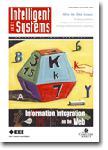版权所有:内蒙古大学图书馆 技术提供:维普资讯• 智图
内蒙古自治区呼和浩特市赛罕区大学西街235号 邮编: 010021

作者机构:University of Vienna Austria University of Vienna Dept. Med. Cybernet. Artif. Intell. Austria Vienna University of Technology Austria Knowledge-Based Systems Group Austrian Res. Inst. Artif. Intell. Austria Europ. Coord. Comm. Artif. Intell. Austria Austrian Res. Inst. Artif. Intell. A-1010 Vienna Schottengasse 3 Austria Department of Pediatrics Austria Dept. Neonatology and Intensive Care University of Vienna Faculty of Medicine Austria University of Vienna Austria Dept. of Pediatrics Univ. of Vienna A-1090 Vienna Währinger Gürtel 18-20 Austria Institute of Software Technology Vienna University of Technology Austria University of Vienna Vienna University of Technology Austria Inst. of Software Technology Vienna Univ. of Technology A-1040 Vienna Resselgasse 3/E188 Austria
出 版 物:《IEEE Intelligent Systems and Their Applications》 (IEEE Intell Syst their Appl)
年 卷 期:1998年第13卷第1期
页 面:65-69页
学科分类:0808[工学-电气工程] 0809[工学-电子科学与技术(可授工学、理学学位)] 08[工学] 0802[工学-机械工程] 0811[工学-控制科学与工程] 0812[工学-计算机科学与技术(可授工学、理学学位)]
主 题:Pediatrics User interfaces IEEE members Societies Meeting planning Lakes Executive Committee Voting Student activities Conference management
摘 要:Planning and calculating adequate nutritional support for sick or premature newborn infants in an intensive care unit is tedious, time-consuming work. Besides requiring considerable expert knowledge and practical experience, this task is prone to inherent, possibly fatal, calculation errors. To automate this process, we built several versions of the Vienna Expert System for Parenteral Nutrition of Neonates (VIE-PNN) knowledge-based system for prescribing parenteral (intravenous) nutrition supply. Unfortunately, clinicians did not employ these initial versions in their daily routine. This article describes our recent redesign of VIE-PNN using an HTML-based client-server architecture. We have integrated this tool into the intranet of workstations that runs a clinic s patient-data-management system. Its acceptance among physicians has been immediate. Two neonatal ICUs at the University of Vienna have put this integrated version into daily use. Factors underlying this knowledge-based system s successful operation include its ease of use, minimal required input, robustness, explanation facilities, and, most important, time savings compared to hand calculation.